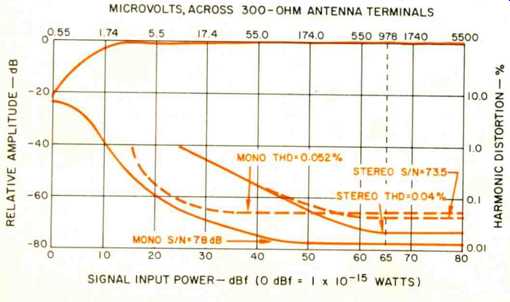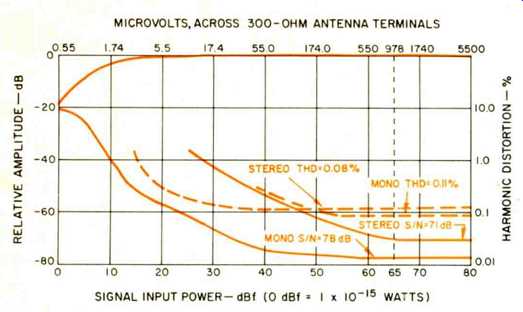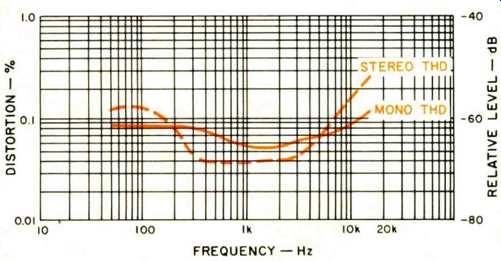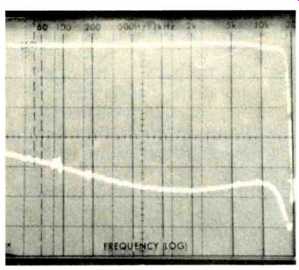
MANUFACTURER'S SPECIFICATIONS:
Usable Sensitivity: 10.3 dBf (1.8 NV).
50-dB Quieting Sensitivity (Mono/ Stereo): 14 d Bf/34 dBf.
S/N (Mono/Stereo): 78 dB/ 75 dB.
THD at 1 kHz: Mono, Wide/Narrow, 0.04 percent/0.08 percent; Stereo, Wide/Narrow, 0.06 percent/0.2 percent.
Frequency Response: 30 Hz to 15 kHz, +0.4, -0.8 dB.
Capture Ratio (Wide/Narrow): 1.0 dB/ 1.5 dB.
Selectivity (Wide/Narrow): 35 dB/85 dB.
I.F., Image, and Spurious Response Rejection: 110 dB.
AM Suppression: 60 dB.
Stereo Separation at 1 kHz (Wide/ Narrow): 55 dB/45 dB.
Stereo Separation from 50 Hz to 10 kHz (Wide/Narrow): 40 dB/32 dB.
Sub-Carrier Rejection Ratio: 70 dB.
Muting Threshold: 10 dBf (1.74 pV).
Output Level (Variable): 0 to 1.3 V at 1 kHz, 100 percent modulation.
Output Level (Fixed): 0.65 V at 1 kHz, 100 percent modulation.
General Specifications:
Power Requirements: 120 V, 60 Hz, 18 watts.
Dimensions: 19-in. (48.3 cm) W x (6.4 cm) H x 10-in. (25.4 cm) D.
Weight: 12.1 lbs. (5.5 kg).
Price: $399.95.
Nikko's Gamma I FM-only tuner is a rack-mountable unit which occupies only 2% inches of vertical rack space. Its sol id-looking front panel, finished in matte black anodized aluminum, features a large dark-colored cut-out area which houses a linearly calibrated FM frequency scale (with markings at every 0.5 MHz), signal-strength and center of channel tuning meters, and the usual stereo indicator light. The cut out area is asymmetrically positioned on the front panel, as are the meters within the cutout area itself. To the right of the dial area is a large flywheel-coupled tuning knob, while all remaining controls are positioned at the left end of the panel. These include a lever-switch for power turn On, a rotary output level control, and three pushbuttons for selection of wide or narrow i.f. mode, a high-frequency stereo-blend switch (for noise reduction when listening to weak-signal stereo), and a mode switch for selection of mono or stereo reception. This latter switch defeats the muting circuit when mono is selected and, conversely, the muting circuit is always engaged when the stereo mode is selected.
The rear panel of the Gamma I is equipped with the usual array of 75-ohm and 300-ohm antenna terminals with the 75-ohm input duplicated in the form of a standard coaxial connector. Variable as well as fixed output jacks are provided and just to their right is a 25/75 microsecond de-emphasis switch for those users who wish to equip their systems with an external Dolby FM adaptor. The rear panel also includes an FM detector output jack, as well as jacks for connection to the horizontal and vertical inputs of an oscilloscope for observation of multipath signals.
Virtually no information regarding the circuit design or approach was provided in the owner's manual, but a cursory examination of the internal construction of the unit revealed that the front end is equipped with dual-gate MOS-FETs and, of course, the availability of wide and narrow i.f. modes suggests a rather elaborate i.f. circuit design. The phase-lock loop approach is used in the stereo decoder section.
Laboratory Measurements
Many of the performance measurements of the Gamma I (or, for that matter, of any tuner which boasts selectable i.f. bandwidth) had to be taken for each i.f. mode setting, since the change from narrow to wide i.f. mode alters the entire performance of the tuner.
In the wide mode, usable sensitivity measured 12.43 dBf (2.3 pV) in mono and 25.2 dBf (10.0 pV) in stereo. Switching to the narrow mode, usable sensitivity became somewhat poorer, as was to be expected, with a reading of 14.14 dBf (2.8 pV), while stereo usable sensitivity remained essentially unchanged. The 50-dB quieting point in mono (regardless of i.f. bandwidth setting) measured 14 dBf, exactly as claimed, but in the stereo mode, the 50-dB quieting signal strength was 35 dB (31 pV) for the wide position and an unusually high 45 dBf (97 pV) in the narrow setting.
The curves of Fig. 1 show mono and stereo quieting and distortion characteristics with increasing signal strength for a 1-kHz, 100-percent modulation signal. Distortion at 65 dBf for the wide i.f. setting was incredibly low in both mono and stereo, with readings of 0.052 percent and 0.04 percent. Signal-to-noise ratio measured 78 dB in mono and 73.5 dB in stereo in the wide i.f. setting. Corresponding results using the narrow i.f. setting are shown in the curves of Fig. 2. The classical trade-off between distortion and selectivity is clearly seen, since distortion now read 0.11 percent in mono and 0.08 percent in stereo. While S/N in mono remained constant at 78 dB, it was slightly lower for the narrow settings with a reading of 71 dB. Considering the high order of selectivity achieved with this setting, however (better than 80 dB), these results are still quite outstanding. It could be argued that the wide i.f. setting really isn't necessary in view of the results obtained in the narrow i.f. mode.

Fig. 1 --Mono and stereo quieting and distortion characteristics in the wide
i.f. mode.

Fig. 2 --Mono and stereo quieting and distortion characteristics in the narrow
i.f. mode.

Fig. 3 --Distortion vs. frequency in the wide i.f. position.
Figure 3 is a plot of mono and stereo distortion versus frequency for the wide i.f. bandwidth setting. Interestingly, distortion at mid-frequencies is actually lower in stereo than it is in mono, though at the frequency extremes, stereo THD rises somewhat, as is to be expected.
Stereo threshold occurs at 25.2 dBf (10 pV), as does the muting threshold in the wide i.f. setting. Muting threshold is a bit lower when the tuner is operated in the narrow i.f. mode, 22.1 dBf or 7.0 uV. I.f., image, and spurious response ratios all measured in excess of 100 dB (the limit of our test setup), while AM suppression measured fractionally better than the 60 dB claimed. Capture ratio was 1.5 dB in the narrow position and 1.1 dB in the wide setting.

Fig. 4 --Frequency response and stereo separation.
Frequency response exhibited a slight rise at around 5 kHz, as can be seen in the upper trace of Fig. 4 (in which each vertical division represents 10 dB of amplitude), and was down just over 1.0 dB at the 15 kHz extreme, relative to the prescribed 75-microsecond de-emphasis characteristic. Stereo separation in the wide mode was excellent, with readings of 54 dB at 1 kHz, 37 dB at 100 Hz, and an unusually high 46 dB at 10 kHz. Switching to the narrow position resulted in some decrease of separation, but not enough to really matter. Separation decreased to 52 dB at 1 kHz, and 43.5 dB at 10 kHz, remaining constant at 37 dB for a 100-Hz test signal. Overall channel separation in the wide mode is depicted by the lower trace in Fig. 4.
Use and Listening Tests
Devoid of unnecessary frills, the Nikko Gamma I proved to be an excellent performer for its price range and picked up about the usual number of mono and stereo signals (more than 50, all told) which we would expect to receive when a high-quality tuner is hooked up to a good five-element out door antenna in our particular listening location. When strong signals were received, we could not detect an audible difference in the quality of sound heard using the wide or narrow i.f. positions, though we did detect some change when we tried to "DX" or zero in on signals having an in coming level of between 15 and 20 dBf. Selecting the "narrow" position under such conditions did reduce noise slightly, but not really enough to make these very low-strength signals usable.
Cosmetically, the unit is functionally handsome, with its large FM dial scale, and it will fit into most front-panel color schemes, what with the matte black and brushed aluminum alternatives. The rack-mount tab cut-outs may prove to be displeasing to some audio buffs who simply wish to place the tuner on a table top or shelf, though this professional look is the "craze" these days.
In summary, the Nikko Gamma I tuner performed quite well considering its price level and should provide just about everything one could wish for in most listening locations.
-Leonard Feldman
-----------------
(Audio magazine, May 1979)
Also see:
Nikko Sta-501S stereo FM/AM Receiver (Mar. 1970)
Nikko Gamma 30 Tuner (Jan. 1987)
Nakamichi Model 730 Stereo FM Receiver (Dec. 1978)
= = = =